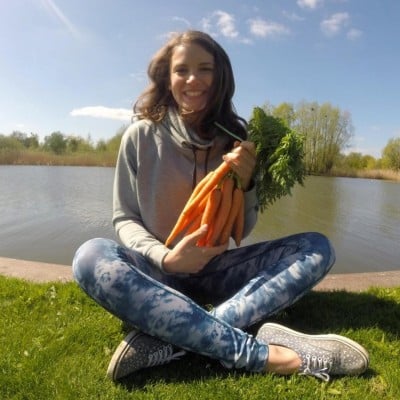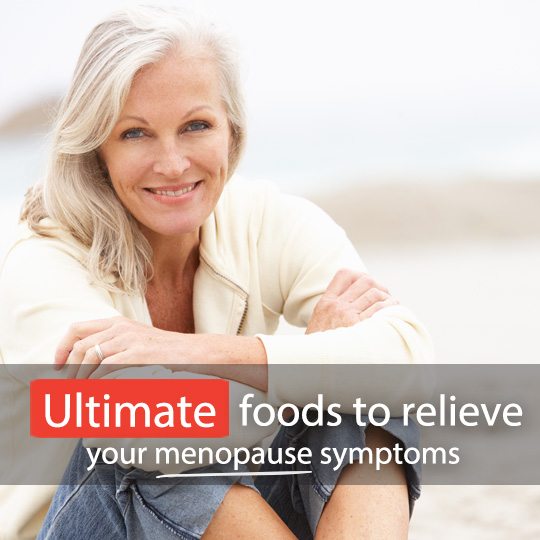The “M” word… terrorizing for some, a natural life-progression for others. And perhaps particularly on your mind if you’re a female approaching the tender age of 50. What am I referring to?
Why, Menopause, of course! Whether you’re starting to feel the first pangs of hot flashes or are simply interested in preparing yourself for a smooth transition, this article is for you.
Read on to find out more about the foods to favor and the ones to watch out for when aiming to optimize your diet for menopause.
[hr]
Let’s Talk Hormones
Before we dive straight into the foods to have on hand and those to keep at an arm’s length, let’s first quickly recap what menopause entails. This will be helpful in understanding why the foods listed below are so important.
Menopause starts when a woman’s ovaries begin running out of eggs. As a reference point, this typically occurs between the ages of 45 and 55, but, since the total amount of eggs each woman is born with can vary, so can the age at which each reaches menopause.
Running out of eggs cause the ovaries to decrease their production of two important reproductive hormones; estrogen and progesterone. It’s this drop that causes most of the changes (and new challenges) associated with menopause, including hot flashes, night sweats, weight gain, bone loss, sleep disturbances and / or mood changes!
Hormone therapy is one way to reduce the symptoms and, while it can be effective, it also raises risks of medical conditions such as heart attacks, stroke and breast cancer, especially if you wait for several years beyond menopause to begin it. Another way to reduce symptoms is through a healthy diet, which, although always important, is particularly so during life-stage.
Certain foods will not only help provide relief of the less than eagerly awaited symptoms described above, but can also ensure your health remains in top-shape, so you can enjoy the many years to come.
Since not all women experience the same symptoms, this article is organized in sections. Read them all or simply scroll through the list below to find yours. Each section will give you some tips on which foods to favor and which to stay away from to get the best benefits. Happy reading!

Mood Swings
As some of you may have noticed, thanks to menopause, mood swings may not only seem worse, but also more difficult to handle. What’s more, many post-menopausal women also report increased feelings of depression and anxiety.
Luckily, several foods can help you deal with such these pesky negatives!
The first set all have one nutrient in common; tryptophan. This little amino acid plays an big role in the manufacturing of serotonin, a neurotransmitter that affects your mood, sleep and appetite. Getting your fill will likely result in a happier disposition as well as better sleep and perhaps even a slimmer waist. Tryptophan is easily found in foods such as turkey, seafood, spinach, cottage cheese, turnips, oats, legumes and pumpkin, sunflower or sesame seeds.
The second contain omega-3 fatty acids. Well-known for their positive effects on heart health, omega-3s may also positively impact levels of serotonin. To achieve an optimal intake, favor foods such as fatty fish, flaxseed, chia seeds, canola oil and nuts.
A third nutrient that may help ward off feelings of depression is none other than vitamin D. Although no research to date has effectively identified a low vitamin D intake as a cause of depression, research does point to a relationship between low levels of vitamin D and depression.
And, given vitamin D’s many positive effects (including those you’ll find listed in the bone health section), ensuring you consume sufficient amounts is, at the very least, unlikely to hurt!
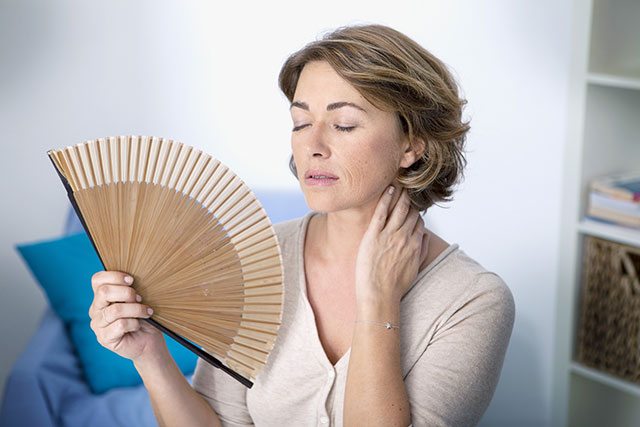
Hot Flashes
Annoying at the very least and full-fledged sleep-disturbing and cumbersome at the most; hot flashes are one symptom many post-menopausal women have to deal with!
To minimize their occurrence, try staying clear of high-fat, high-sugar diets, spicy foods, excessively hot drinks or caffeine, as each of these items can act as triggers.
As for foods to favor, you might want to consider adding soy products to your diet. Why? Research currently supposes that a high intake of soy isoflavones (which can be found in all soy products) are part of the reason why Japanese women experience much less hot flashes than Westerners.
The amount of isoflavones needed for relief seems to be about 50 mg, which can be easily provided by two servings of soy foods per day. Examples of one serving include 1/2 cup of tofu, tempeh, edamame, cooked soybeans or 1 cup of soy milk.
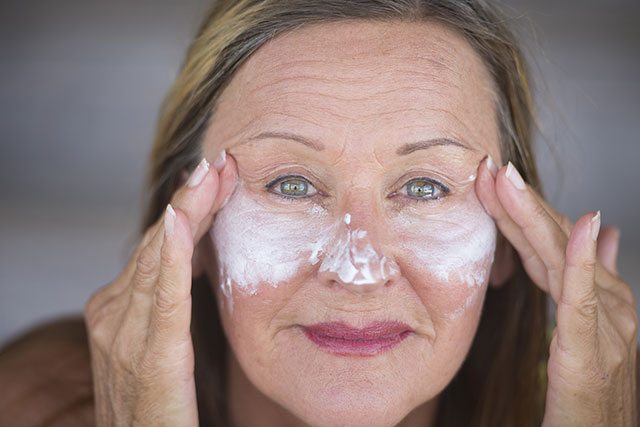
Bad Skin
Although crow’s feet and laugh lines are a normal part of the aging process, the declining estrogen levels associated with menopause can accelerate said process, bringing on unwanted extras such as dry and scaly skin.
This might come as no surprise, but filling up on antioxidant-rich plant foods can help minimize the toll aging takes on your skin. That’s because the more antioxidants you consume, the stronger of an army you create when it comes to fighting off cell-aging oxidative damage.
Three particularly useful antioxidants are zinc and vitamins A & C.
– Vitamin C rich foods include bell-peppers, kale, kiwis, broccoli, berries and citrus fruit .
– The best sources of zinc include seafood, meat, seeds, beans and lentils.
– Vitamin A can be found in orange-colored vegetables such as carrots, sweet potatoes, winter squash as well as in leafy greens.
Again, you might want to give boosting your soy isoflavone intake a try. A study conducted in middle-aged women found that those who consumed 40mg of isoflavones (about the amount in 1 1/2 servings of soy foods) every day, for 12 weeks, experienced improved skin elasticity and a decline in small wrinkles.
Finally, drinking up can help maintain the moisture of your skin, offsetting dryness. What’s more, getting your 8 glasses per day can also help decrease some of the bloating that sometimes occurs with hormonal changes. If you’re not a fan of bland water, you’ll be glad to read that soups, herbal teas and frozen-fruit or mint-flavored water are just as effective!

Weight Gain
Yet another popular complaint! Although most women may feel otherwise, menopause may not be to blame per-se…
But, while there’s still much debate surrounding the exact cause of menopausal weight gain, the fact remains that many post-menopausal women experience this annoying side-effect. To help keep the extra pounds from finding residence around your midsection, make sure to give the following 3 tips a try!
- Make sure to boost your fibre intake. You can easily achieve this by increasing your intake of fruits, vegetables and whole grains. Fibre expands in your stomach, which will keep you feeling fuller for longer, preventing hunger pangs (or excessive over-eating). A high-fibre diet might also slightly lower estrogen levels prior to menopause, helping make the transition a little smoother! Last, but not least, soluble fibre can also help lower cholesterol, protecting both your heart and brain!
- Get your move on! One of the main culprits when it comes to weight gain is the slowing down of your metabolism, mainly brought upon by age-associated loss of muscle mass. Since muscle burns more calories than fat, a decrease in muscle mass can result in stacking on the pounds, despite eating the same way as you have for years. You can prevent this from happening by simply adding some resistance-training 2 – 3 times per week. Plus, strong muscles will also help keep your bones strong.
- Consider seeking out a registered dietitian near you (no plug intended)! A recent study examined the eating habits of 419 overweight and obese menopausal and postmenopausal women. Some were set up with regular meetings with registered dietitians while the others received only limited health education. After 4 years, 57% of those who met with a dietitian maintained their weight-loss compared with only 29% of controls! Favoring a nutrition check-up at this important life point can be motivating, in addition to providing you with handy tips to keep you healthy for years to come.
As an added bonus, slimming down also reduces the risk of heart disease and breast cancer, which both go up after menopause.
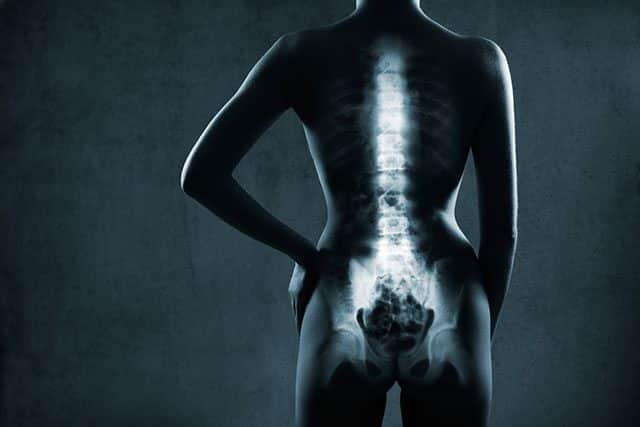
Weak Bones
If you’ve read this far, you’re definitely ready for the longest, but potentially the most important section of this article.
The drop in estrogen production you’re bound to experience during menopause can negatively affect the structure of your skeleton! And, since women’s bones are less dense than men’s to begin with, prioritizing your bone health will help prevent your bones from breaking or your spine from buckling over with age. To avoid the ensuing less-than-flattering Quasimodo look, make sure you give the following nutrients starring roles in your daily food choices.
1) Calcium, Calcium, Calcium!
Although this mineral represents only 1 – 2% of your whole body weight, more than 99% of it finds residence in your skeleton. No wonder calcium and bones have become such a well-recognized duo! And although peak bone mass is typically achieved in our twenties, it doesn’t mean that you shouldn’t aim for an optimal intake in your 30s, 40s, 50s and beyond.
Think of it this way: up to your thirties, the calcium you ingest helps build your bone mass and, from then on, helps slow down its decline. And since the biggest bone loss tends to occur in the first 5 years following menopause, failing to get your fill can leave you with a significantly brittler skeleton.
To make sure you get your fill, aim to consume 1000mg per day pre-menopause and 1200mg per day once you hit the big “M”. It’s best to do so by opting for these calcium-rich foods, as they will also provide you with an interesting array of other handy nutrients.
If you find yourself unable to achieve this intake through diet alone, you may want to consider opting for a supplement. But do not exceed 500mg per dose, as your body is limited in how much calcium it can absorb at once.
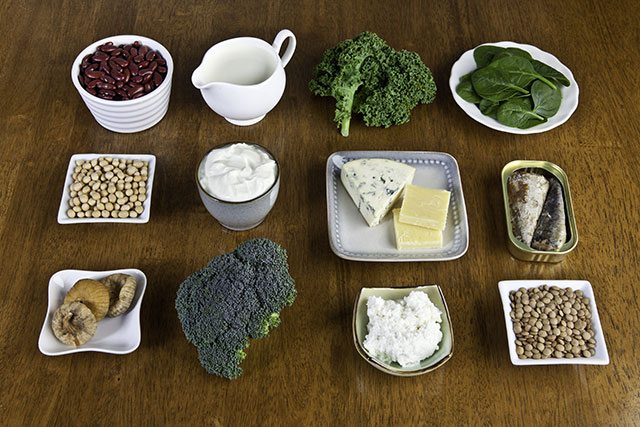
2) Vitamin D
Also know as the sunshine vitamin, one of vitamin D’s main roles is to help your intestines absorb the calcium you eat. Put simply, eating enough calcium won’t help if you can’t absorb said calcium! For this reason, vitamin D plays a crucial role when it comes to your bone health.
Let me put it this way: if our ancestors had to rely on foods to get their vitamin D fix, our species wouldn’t have lasted very long! That’s because not many foods contain any. Luckily, our body can produce its own through simple exposure to the sun. All it takes is 10 – 30 minutes spent in the midday sun, without sunscreen, 3 times a week on days where sunburn is possible. But keep in mind this is only an average, as the darker your skin, or the older you are, the more sun exposure you need.
N.B. Those living in northern latitudes (where exposing the arms and legs to the sun may not be so practical between the months of October and May) may want to consider a daily vitamin D supplement, providing between 600 – 1000 IU.
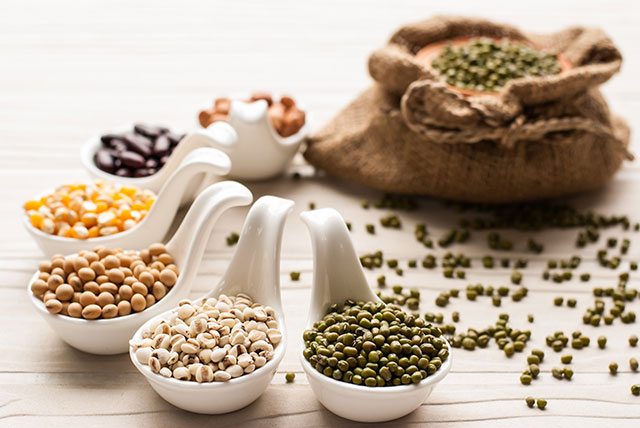
3) Protein
After decades of criticism for alleged bone-damaging effects, protein is now back on the list of bone-protecting nutrients. In addition to building and maintaining your muscles (which are super important for the overall health of your skeleton), eating enough protein can also help increase calcium absorption, stimulate bone growth and slow down bone loss.
To ensure you get enough, include a source of protein at each meal (including breakfast) as well as with each snack. Top choices include meats, dairy products, beans, eggs, nuts and seeds.
4) Vitamin K
This perhaps less-know vitamin plays, none the less, an essential role in bone health. So much so that research found that a low vitamin K intake is linked to poorer bone mineral density (an indicator of bone health) in both women and men.
You can get your daily fill by favoring vitamin K-rich foods such as leafy green veggies (think spinach, kale, and beet greens) as well as soy, canola and olive oils. And since a little fat can enhance vitamin K absorption, why not give your spinach a quick sauté in one of the oils listed above? You’ll be set to go!
5) Potassium
By helping balance out acidity-causing factors, potassium-rich foods may help reduce calcium loss from bone. It’s quite difficult to reach your potassium needs if you aren’t eating a diet rich in fruits, vegetables and legumes… so at the risk of sounding like a cliché of a dietitian, make sure you include some veggies at each meal!
Top potassium-rich choices include kidney and lima beans, avocados, beet greens, spinach, Swiss chard, sweet potatoes, bananas as well as tomato and orange juices.

6) Magnesium
Consuming enough magnesium-rich foods is linked to better bone health, whereas magnesium deficiency raises the risk of bone disease in women. That, in my book, makes a pretty strong case for getting your daily fill!
To do so, favor whole grains, legumes, nuts, seeds and green leafy vegetables. And, in case you hadn’t noticed, most of these foods can also be found on the potassium-rich list; talk about lighting two candles with one matchstick!
7) Vitamin C
Vitamin C is needed for synthesis of the connective tissue found in the bone matrix, which means that eating enough of it can help your bones stay strong. But before you run out to the health store to stock up on supplements, note that vitamin C is one of the easiest vitamins to include in your diet! To get enough, all you need to do is… you’ve probably guessed it; fill your plate with fruits and vegetables!
Now that you know what to eat, here’s what to stay away from:
Bone Thieves
Bone Thief # 1: Smoking
Smoking robs the bones by decreasing the absorption of calcium from the diet. Smokers also tend to experience menopause at a younger age, which means they’re unwillingly extending the total amount of years spent in the life-period during which bone loss is highest.

Bone Thief # 2: Salty diets.
Too strong of a love affair with the salt shaker can promote the loss of calcium in the urine, regardless of how much calcium is actually consumed in the diet. Studies even show that daily sodium intakes exceeding 2100mg per day are linked to important negative effects on bone density. To put it into context, 2100mg per day represents half of the amount of salt you’d find in 1 Big Mac, 250ml of canned soup or 2 glasses of vegetable juice.
To keep your sodium intake within recommendations, use a light hand when salting your food, and keep processed (a.k.a. salt-loaded) foods to a minimum.
Bone Thief # 3: Alcohol
When it comes to drinking, you might have heard that a moderate alcohol intake can bring on many health benefits (especially if said alcohol is red wine). The reverse of the medal is that too much alcohol not only negates said health benefits, but can also lead to poorer bone health and increased risk of fracture. The bottom line ladies; for your bone’s sake, keep it to less than 2 drinks per day!
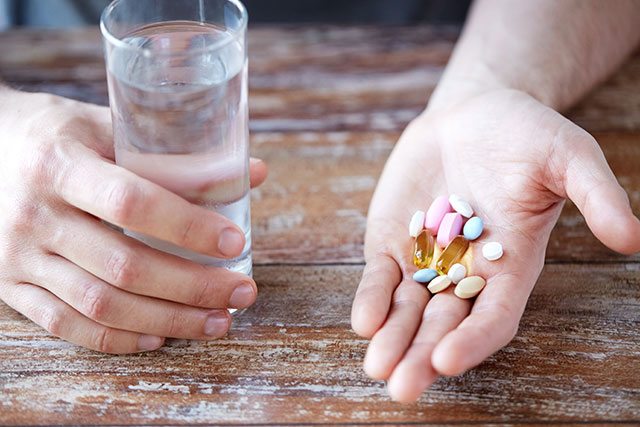
What About Supplements?
There’s indeed a wide variety of herbal remedies on the market claiming to combat menopausal symptoms, the most often-mentioned of which are dong quai, evening primrose oil and ginseng. The unfortunate truth is that most herbal supplements haven’t been thoroughly studied, which means they might bring on negative side-effects of their own or interact with other medications you may be consuming. That’s not to say they can’t help, but your best bet remains speaking to your healthcare professional before starting to take any of these.


